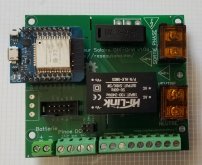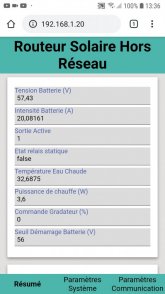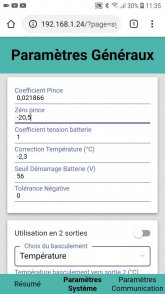With the help of a French technician, we created a solar router, capable of heating water thanks to the excess solar power supplied by the solar panels.
When the hybrid inverter is near the end of charging the batteries, and the inverter load is not at its maximum, if there is still the possibility of drawing energy from the solar panels, this energy is sent to the water heater, step by step, without discharging the batteries. We monitor the charging voltage of the batteries as well as the charging / discharging current of the batteries with a DC clamp . We use for this an ESP32 micro controller, a 40 amperes triac, a DC clamp .HST016L
the system has a web interface to access settings and controls. It is open source available to everyone. The project is in French language, the system works in 110V-240V 50/60 hertz. We have 2 version, "La Mini" with 1 triac output, and "La Maxi", with 2 triac output and one SSR output
When the hybrid inverter is near the end of charging the batteries, and the inverter load is not at its maximum, if there is still the possibility of drawing energy from the solar panels, this energy is sent to the water heater, step by step, without discharging the batteries. We monitor the charging voltage of the batteries as well as the charging / discharging current of the batteries with a DC clamp . We use for this an ESP32 micro controller, a 40 amperes triac, a DC clamp .HST016L
the system has a web interface to access settings and controls. It is open source available to everyone. The project is in French language, the system works in 110V-240V 50/60 hertz. We have 2 version, "La Mini" with 1 triac output, and "La Maxi", with 2 triac output and one SSR output





